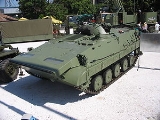
BVP M-80
Encyclopedia
The BVP M-80, is a Yugoslavian infantry fighting vehicle
, produced in the 1980s until the Yugoslav civil wars in the 1990s.
The first production variant was the M-80 which was only made in small numbers. The vehicle used a French built engine with an output of 260 hp, the same engine as used in AMX-10P. After only a year, Yugoslavia
started license production of Daimler-Benz
's 320 hp engine in domestic FAMOS factories. This variant received a new designation as M-80A.
At the time it was produced, M-80A had similar characteristics with existing IFVs like Russian BMP-1
or French AMX 10P. Although many foreign experts compare M-80A with Russian BMP-1, the Yugoslav IFV is a true original design. Unlike the BMP-1 which had 6 support wheels and was armed with 73 mm gun, M-80A had 5 support wheels and had 20 mm gun. M-80A incorporates numerous elements from the newer BMP-2
and the French AMX-10P
giving it more power and better protection over its counterpart. All M-80As are amphibious and are equipped with twin AT-3 launchers.
It was used extensively during the Yugoslav Wars
.
Infantry fighting vehicle
An infantry fighting vehicle , also known as a mechanized infantry combat vehicle , is a type of armoured fighting vehicle used to carry infantry into battle and provide fire support for them...
, produced in the 1980s until the Yugoslav civil wars in the 1990s.
Development
Early research and development of the M-80 began in 1969, with testing of the first completed prototype in 1974. First examples of the, BVP M-80 rolled out in 1979 but full entry to service happened in 1982. An upgraded model was unveiled a year after with a designation M-80A. This variant had a more powerful engine and somewhat better armor. Around 800 vehicles were produced before the breakup of the country.The first production variant was the M-80 which was only made in small numbers. The vehicle used a French built engine with an output of 260 hp, the same engine as used in AMX-10P. After only a year, Yugoslavia
Yugoslavia
Yugoslavia refers to three political entities that existed successively on the western part of the Balkans during most of the 20th century....
started license production of Daimler-Benz
Daimler-Benz
Daimler-Benz AG was a German manufacturer of automobiles, motor vehicles, and internal combustion engines; founded in 1926. An Agreement of Mutual Interest - which was valid until year 2000 - was signed on 1 May 1924 between Karl Benz's Benz & Cie., and Daimler Motoren Gesellschaft, which had...
's 320 hp engine in domestic FAMOS factories. This variant received a new designation as M-80A.
At the time it was produced, M-80A had similar characteristics with existing IFVs like Russian BMP-1
BMP-1
The BMP-1 is a Soviet amphibious tracked infantry fighting vehicle. BMP stands for Boyevaya Mashina Pekhoty 1 , meaning "infantry fighting vehicle". The BMP-1 was the world's first mass-produced infantry fighting vehicle...
or French AMX 10P. Although many foreign experts compare M-80A with Russian BMP-1, the Yugoslav IFV is a true original design. Unlike the BMP-1 which had 6 support wheels and was armed with 73 mm gun, M-80A had 5 support wheels and had 20 mm gun. M-80A incorporates numerous elements from the newer BMP-2
BMP-2
The BMP-2 is a second-generation, amphibious infantry fighting vehicle introduced in the 1980s in the Soviet Union, following the BMP-1 of the 1960s....
and the French AMX-10P
AMX-10P
The AMX-10P is a French infantry fighting vehicle. It was developed after 1965 to replace the AMX-VCI in French service, and the first prototypes were completed in 1968. It has NBC protection and amphibious capabilities, with hydro jets to swim in water...
giving it more power and better protection over its counterpart. All M-80As are amphibious and are equipped with twin AT-3 launchers.
It was used extensively during the Yugoslav Wars
Yugoslav wars
The Yugoslav Wars were a series of wars, fought throughout the former Yugoslavia between 1991 and 1995. The wars were complex: characterized by bitter ethnic conflicts among the peoples of the former Yugoslavia, mostly between Serbs on the one side and Croats and Bosniaks on the other; but also...
.
Characteristics
The M-80A is armed with one 20 mm gun, co-axial machine gun 7.62 mm and twin launcher for wire guided anti-tank missiles. It is NBC protected, fire suppression system, inside heating and water ejecting system. It’s fully amphibious and can perform crossing of any water barrier without previous preparations. Max. speed at water is 7 km/h. Crew consist of three, driver, commander and gun operator and in the after compartment there is space for six fully equipped infantrymen who can engage the enemy with personal armament through six gun slits on both vehicle sides and back doors and one squad leader who commands infantry upon exiting the vehicle. Infantry leaves IFV through two doors at the back of the vehicle.Variants
- M-80 - First production model with 260 hp engine, replaced after 1 year.
- M-80A - Improved version with 320 hp engine, full production.
- M-80A1 - Twin 30-mm anti-aircraft cannon, prototype only;
- M-80A KC - Company commander's vehicle.
- M-80A KB - Battalion commander's vehicle.
- M-80A Sn - Medical, no turret. Single oblong hatch in the roof and single rear door. Carry's 4 stretcher patients or 6 seated patients.
- M-80A LT - Tank hunter version with six AT-3 launchers.
- Sava M-90 - SA-13 Surface-to-air missile launcher, designated Strela-10MJ, prototype.
- SPAT 30/2 - Self-Propelled Ant-aircraft gun. Made with mounting of two 30mm cannons. The aim-scan gear is J-171 ore Motorola 6800.
- MOS - Self-propelled mine layer.
- M-80AK/M-98A - single 30mm cannon and new gun turretGun turretA gun turret is a weapon mount that protects the crew or mechanism of a projectile-firing weapon and at the same time lets the weapon be aimed and fired in many directions.The turret is also a rotating weapon platform...
.

